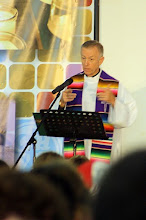 Though these words were given by Robert Bolt to Thomas More in the trial scene and final scene of A Man For All Seasons, referring to More’s own execution, they can have wider implications for many of us.
Though these words were given by Robert Bolt to Thomas More in the trial scene and final scene of A Man For All Seasons, referring to More’s own execution, they can have wider implications for many of us.I’ve been on a ‘death-watch’ for the last 10 days—a man suffering from a complex of conditions that had him in ICU for a week; he’s now been in a Hospice wing room for a week. It seems that, close as he is to dying, he and God are not ready for his final breath just yet. I stood at the bedside with the family for over an hour Saturday—we were sure his passing was minutes away. As I write this, however, it’s been over 18 hours more…
I have had spiritual counseling sessions with several others who have lost their jobs, often in circumstances that seem grossly unfair. There is a kind of death involved here, too: a death of self-respect and dignity. New jobs can go a long way toward restoring a person’s sense of worth, but it typically is not a resurrection that happens after only three days.
After checking on Facebook this morning, I found that one of my “friends” there (a young woman whom I first got to know in 1997 when she was in 4th grade) has changed her status to “single.” She was married; she has a child. What happened to cause the death of that relationship? I have no idea, but a death surely occurred there.
We are approaching Ash Wednesday (which of course here in Mobile means the day marking the end of two weeks’ worth of Mardi Gras parades, balls and general partying). And here I take a cue from St Augustine, who loved to make theological points based on the etymology of words (no matter how wrong his etymology actually was!). Mine will be wrong, too—but I am doing this deliberately.
Lent (our penitential season of preparation for Easter and the celebration of the sacraments of Christian Initiation) is a word that actually comes from the Old English lencten, meaning “spring.” But I want to associate the word instead with the Italian lento, meaning “slow.” Lent’s emphasis is also on dying—to self-centeredness, to sin. How good for us would it be to slow down, take serious stock, and see where we need to shed our selfishness and expand our sense of connection with God and others through the traditional practices of fasting, almsgiving and prayer?
The Church Fathers always linked these three practices together, insisting that in this way we become more like the children of God we were meant to be (“the best version of ourselves,” as Matthew Kelly would put it). Would it not be special to realize, after the “slowing-down” period of Lent, that Easter saw in us a real resurrection of graced life after dying to what is unnecessary or sinful in us?
UPDATE: Mike Walsh (1st paragraph above) died this morning at about 10:10 am. Please pray for the Walsh family.
